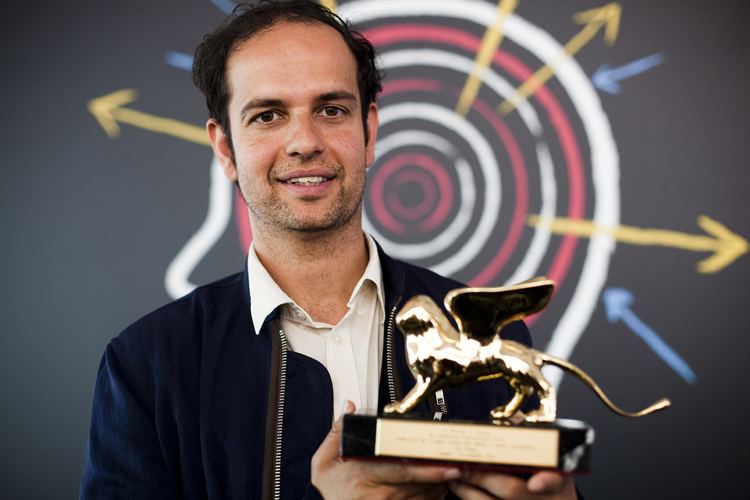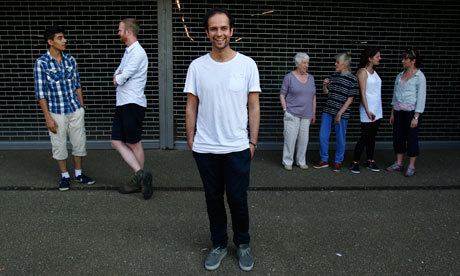Nationality British–German | Name Tino Sehgal Role Artist | |
 | ||
Education Humboldt University of Berlin Nominations | ||
Artist Talks: Tino Sehgal - about his work "Kiss"
Tino Sehgal (; [ˈzeːgaːl]; born 1976) is a British–German artist, based in Berlin, who describes his work as "constructed situations". He is also thought of as a choreographer that makes dance for the museum setting.
Contents
- Artist Talks Tino Sehgal about his work Kiss
- Biennale arte 2013 tino sehgal
- Personal life
- Career
- Exhibitions
- Collections
- Awards
- References

Biennale arte 2013 tino sehgal
Personal life

Sehgal was born in London and raised in Düsseldorf, Paris, and a town close to Stuttgart. His father was born in British India, and was a member of the Punjabi Sehgal family, but "had to flee from what is today Pakistan when he was a child"; his mother was "a German native and homemaker." He studied political economy, conceptual art and dance at Humboldt University, Berlin and Folkwang University of the Arts, Essen. He danced in the company of French experimental choreographers Jérôme Bel and Xavier Le Roy. In 1999, Sehgal worked with the dance collective Les Ballets C. de la B. in Ghent, Belgium, and developed a piece entitled Twenty Minutes for the Twentieth Century, a 55-minute series of movements performed naked in twenty different dance styles, from Vaslav Nijinsky to George Balanchine to Merce Cunningham, and so forth. Sehgal met his wife, Dorothea von Hantelmann, when he was twenty three at a party after a dance performance (von Hantelann is an art historian). Their work has become very meshed within one another's as von Hantelmann wrote How to Do Things with Art, which featured an entire section on Sehgal's work: Object and Situation in the work of Tino Sehgal. They have been married for seventeen years and live in Berlin with their two sons.
Career

All of Sehgal's works exist ephemerally and are documented only in the viewer's memory. The artist himself describes his works as 'constructed situations'. His materials are the human voice, language, movement, and interaction. He resists the production of physical objects. Sehgal's pieces are choreographies that are regularly staged in museums or galleries, and continuously executed by trained individuals he refers to as “interpreters” for the entire duration of a show. The artwork is the constructed situation which arises between the audience and the interpreters of the piece.

In This is So Contemporary (2005), performers danced in a happy, emphatic way around visitors entering the exhibition space, singing, "Oh, this is so contemporary, contemporary, contemporary. Oh, this is so contemporary, contemporary, contemporary." The catchy melody and exciting dances left some of the museum visitors cheerful and dancing, themselves.

Sehgal’s work Kiss (2007), exhibited at the Museum of Contemporary Art, Chicago, was his first work in an American museum. Presented in association with the MCA’s show "Collection Highlights," Kiss is a sculptural work—two dancers kiss and touch, eventually resembling embracing couples from historical works of art; the work appropriates the different amorous poses in Auguste Rodin's The Kiss (1889), Constantin Brâncuși's The Kiss (1908), Gustav Klimt's The Kiss (1907–08), Jeff Koons and La Cicciolina's Made in Heaven (1990–91) and various Gustave Courbet paintings from the 1860s one after the other.
In Sehgal's 2010 work This Progress at the Guggenheim Museum, New York, the artist empties Frank Lloyd Wright's famed spiral gallery of all art work. The museum visitor is met at the base of the spiral by a child, who asks a small group what they think progress is. As they begin their ascent up the spiral ramp the visitors continue their conversation until they are met by a high school student who picks up the conversation and asks further non-sequitur questions. Further still, they are met by a young adult and lastly an older adult who finishes their ascent to the upper-most point in the Guggenheim.
In This Success/This Failure (2007) young children attempt to play without using objects and sometimes draw visitors into their games.
For This is Good (2001) a museum worker waves their arms and hops from one leg to the other, then states the title of the piece.
For This objective of that object (2004) the visitor becomes surrounded by five people who remain with their backs to the visitors. The five chant, "The objective of this work is to become the object of a discussion," and if the visitor does not respond they slowly sink to the ground. If the visitor says something they begin a discussion.
His most complex work, This Situation (2007), required the participation of a group of intellectuals. They occupied an otherwise empty gallery space and interacted with each other and the audience in accordance with a set of rules and games established by the artist.
For documenta XIII (2012) Sehgal orchestrated This Variation, an immersive piece that places viewers in a nearly dark gallery among some 20 performers who sing, dance, clap, hum and talk, creating "an electrifying aural-spatial experience of pure, unencumbered imagination in action".
In 2012, Sehgal was the 13th artist commissioned by the Tate Modern for its annual Unilever series. The first “live” work in the vast space, These associations consists solely of encounters between around 70 storytellers and visitors to the gallery.
Exhibitions
Sehgal is the youngest artist to have represented Germany at the Venice Biennale (in 2005, together with Thomas Scheibitz). Sehgal had solo exhibitions at a number of important venues including the Stedelijk Museum, Amsterdam (2015); Museum für Moderne Kunst, Frankfurt (2007); the Institute of Contemporary Arts, London (2007, 2006, 2005); Kunsthaus Bregenz, Austria (2006), Kunstverein Hamburg (2006), Serralves Foundation, Porto (2005); Van Abbemuseum, Eindhoven and Musée des Beaux-Arts, Nantes (2004).
Collections
On the sale of his work, Sehgal stipulates that there is no written set of instructions, no written receipt, no catalogue, no pictures and no perceivable meaning. The conversation that constitutes a Tino Sehgal sale consists of his talking to the buyer (usually a representative from a museum) before a notary and witnesses, generally with about five legal stipulations of the purchase: that the work be installed only by someone whom Sehgal himself has authorized via training and prior collaboration; that the people enacting the piece be paid an agreed-upon minimum; that the work be shown over a minimum period of six weeks (in order to avoid allegations of ephemerality); that the piece not be photographed; and that if the buyer resells the concept, he does so with this same oral contract. This means that his work is not documented in any way, apart from critical reviews both admiring and negative. As of 2010, the "constructed situations" sold in editions of four to six (with Sehgal retaining an additional “artist’s proof”) at prices between $85,000 and $145,000 apiece.
Sehgal's This Progress (2010) was the first live work to be acquired by the Solomon R. Guggenheim Museum.
Awards
Sehgal received the Bâloise Prize at Art Basel, Switzerland, in 2004. In 2006, he was shortlisted for the Hugo Boss Prize, and in 2007 for the Preis der Nationalgalerie für Junge Kunst at the Hamburger Bahnhof in Berlin. He was selected as one of four finalists for the 2013 Turner Prize for his “This Variation” and “These Associations” exhibitions.
Tino Sehgal won the Golden Lion for the best artist in the International Exhibition Il Palazzo Enciclopedico (The Encyclopedic Palace) in Venice Biennale 2013 (Central Pavilion, Giardini)
